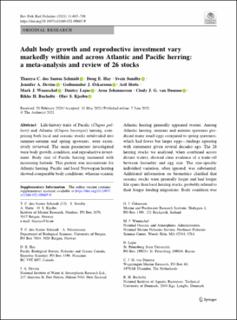| dc.contributor.author | dos Santos Schmidt, Thassya C. | |
| dc.contributor.author | Hay, Doug E. | |
| dc.contributor.author | Sundby, Svein | |
| dc.contributor.author | Devine, Jennifer A. | |
| dc.contributor.author | Óskarsson, Guðmundur J. | |
| dc.contributor.author | Slotte, Aril | |
| dc.contributor.author | Wuenschel, Mark J. | |
| dc.contributor.author | Lajus, D. L. | |
| dc.contributor.author | Johannessen, Arne | |
| dc.contributor.author | van Damme, Cindy J. G. | |
| dc.contributor.author | Bucholtz, Rikke H. | |
| dc.contributor.author | Kjesbu, Olav S. | |
| dc.date.accessioned | 2021-09-10T06:25:13Z | |
| dc.date.available | 2021-09-10T06:25:13Z | |
| dc.date.created | 2021-09-03T13:12:58Z | |
| dc.date.issued | 2021 | |
| dc.identifier.issn | 0960-3166 | |
| dc.identifier.uri | https://hdl.handle.net/11250/2775057 | |
| dc.description.abstract | Life-history traits of Pacific (Clupea pallasii) and Atlantic (Clupea harengus) herring, comprising both local and oceanic stocks subdivided into summer-autumn and spring spawners, were extensively reviewed. The main parameters investigated were body growth, condition, and reproductive investment. Body size of Pacific herring increased with increasing latitude. This pattern was inconsistent for Atlantic herring. Pacific and local Norwegian herring showed comparable body conditions, whereas oceanic Atlantic herring generally appeared stouter. Among Atlantic herring, summer and autumn spawners produced many small eggs compared to spring spawners, which had fewer but larger eggs—findings agreeing with statements given several decades ago. The 26 herring stocks we analysed, when combined across distant waters, showed clear evidence of a trade-off between fecundity and egg size. The size-specific individual variation, often ignored, was substantial. Additional information on biometrics clarified that oceanic stocks were generally larger and had longer life spans than local herring stocks, probably related to their longer feeding migrations. Body condition was only weakly, positively related to assumingly in situ annual temperatures (0–30 m depth). Contrarily, body growth (cm × y−1), taken as an integrator of ambient environmental conditions, closely reflected the extent of investment in reproduction. Overall, Pacific and local Norwegian herring tended to cluster based on morphometric and reproductive features, whereas oceanic Atlantic herring clustered separately. Our work underlines that herring stocks are uniquely adapted to their habitats in terms of trade-offs between fecundity and egg size whereas reproductive investment mimics the productivity of the water in question. | en_US |
| dc.language.iso | eng | en_US |
| dc.publisher | Springer | en_US |
| dc.rights | Navngivelse 4.0 Internasjonal | * |
| dc.rights.uri | http://creativecommons.org/licenses/by/4.0/deed.no | * |
| dc.title | Adult body growth and reproductive investment vary markedly within and across Atlantic and Pacific herring: a meta-analysis and review of 26 stocks | en_US |
| dc.type | Journal article | en_US |
| dc.type | Peer reviewed | en_US |
| dc.description.version | publishedVersion | en_US |
| dc.rights.holder | Copyright The Author(s) 2021 | en_US |
| cristin.ispublished | true | |
| cristin.fulltext | original | |
| cristin.qualitycode | 1 | |
| dc.identifier.doi | 10.1007/s11160-021-09665-9 | |
| dc.identifier.cristin | 1931156 | |
| dc.source.journal | Reviews in Fish Biology and Fisheries | en_US |
| dc.source.pagenumber | 685-708 | en_US |
| dc.identifier.citation | Reviews in Fish Biology and Fisheries. 2021, 31, 685-708. | en_US |
| dc.source.volume | 31 | en_US |

